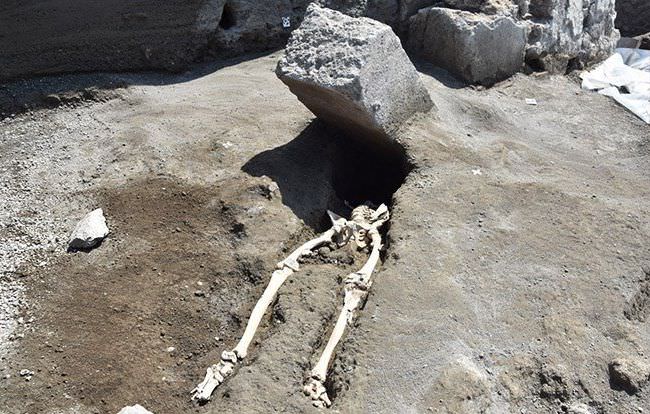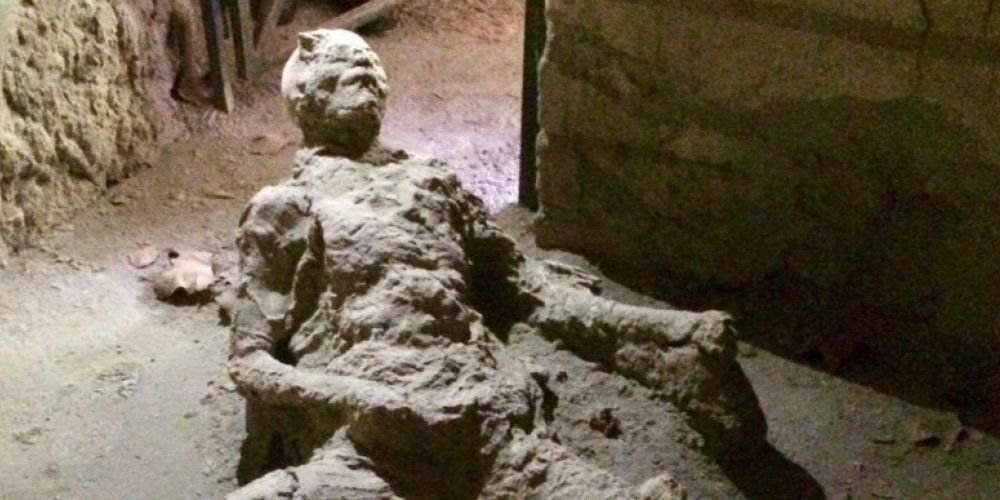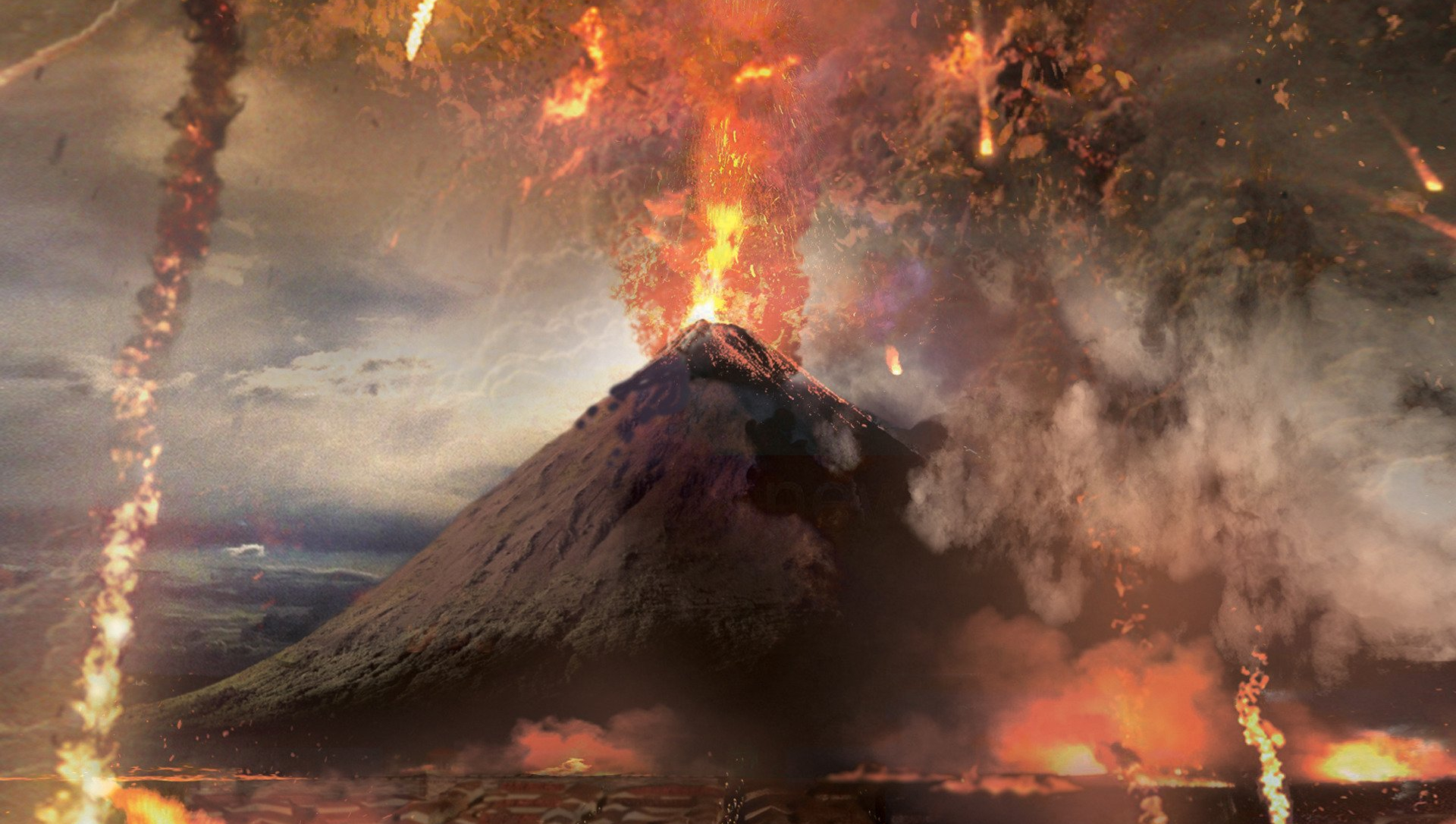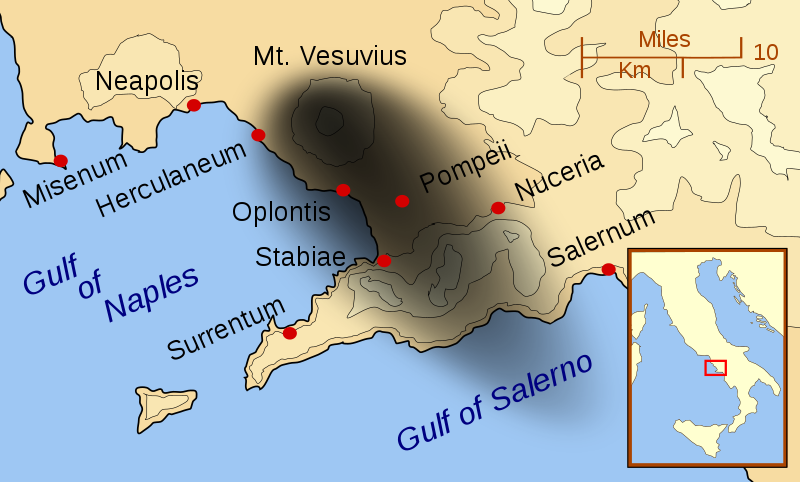In 79CE, Mount Vesuvius, a volcano along the Bay of Naples, erupted catastrophically burying nearby towns in ash. The most famous of these was Pompeii, which remained undiscovered for centuries. When it was discovered, it was practically a time capsule with the ash preserving the city as it had been in its final moments. This extended to the casualties of the eruption, whose remains within the ash could be cast in plaster, capturing their moment of death.
We have a remarkably thorough picture of the eruption and its effects on Pompeii, but jarringly, we don’t know when it happened. Several dates have been put forward for the day of the eruption. Traditionally, it was believed to have occurred on the 24th of August but modern research has offered a date in October.
In the lead up to the eruption, there were indicators that Vesuvius was less dormant than the people living beneath it might have liked. In Pompeii itself, there was a major earthquake in 62AD which was thought to have originated at Vesuvius. The damage was so extensive that when the volcano erupted over fifteen years later, reconstruction work was still being undertaken on some of the buildings.
What follows is a rough timeline following the eruption of Vesuvius and the devastation it caused, including some rather graphic descriptions of how the victims died. I’ve included specific times to make it easier to follow how quickly events moved. Because the eruption occurred around noon, it took place over two days but ultimately Pompeii was wiped from the earth within twenty-four hours of Vesuvius’ erupting.
Day 1
1 hour pre-eruption (11-12 am)
From what we know of the day of the eruption, whichever day that might have been, the weather was fine and clear. Conditions within Mount Vesuvius were less calm and resembled something akin to a natural pressure cooker. The magma chamber was full of lava, rock, and super-heated gases but a dense, rocky plug in the mouth of the volcano prevented any kind of relief for the growing pressure. A small fissure formed near the mouth, allowing a small explosion of steam to escape which saw a shower of fine ash to the East of the mountain.
Onlookers from Pompeii would have been able to see a white cloud sitting atop the mountain but may have dismissed it as normal weather. Meanwhile, minor tremors rocked the city and surrounding areas but this wasn’t uncommon.
Eruption (1:00 pm)
The combination of pressure and gases inside Vesuvius’ magma chamber caused the molten rock within to form into an almost foam-like substance. When the pressure became too much, the rock sealing the mouth of Vesuvius exploded and the volcano erupted sending a column of super heated gas, foam, and pumice into the air reaching heights of up to twenty miles.
The column was visible throughout the Bay but many in Pompeii dismissed it as ‘just smoke’. They went back to their homes and continued their lives thinking that everything was fine. Meanwhile, at the town of Herculaneum, the violence and noise of the eruption were felt with far more drama. They were rocked by earthquakes and were thought to have been the first to witness volcanic lightning from their view of the column.
30 minutes post-eruption (1:30 pm)
As the eruption continued, the debris spewed into the column started to lose thrust as it rose. Typically, the wind would have blown the cloud across the Bay but on this particular day, the cloud began to drift directly over Pompeii. As the column gained altitude the boiling ash mixed with air, cooled, and solidified causing pumice stones to rain down on the city.
This shower of pumice would last in Pompeii for almost the duration of the eruption. The pumice was light and did little outright damage. Instead, it carpeted the ground and rooftops in a coating of ash and rock. The pumice floated on water and could be seen in all of the wells and public water fountains which led people to assume the rocks were harmless. While the pumice itself posed little damage to anyone, scattered among them were colder, dense volcanic rocks torn from the wall of the magma chamber. They were indistinguishable from the pumice stones in the shower but as they fell from the cloud, reaching speeds of up to two hundred miles an hour, they caused the first casualties of the eruption. Many who were struck by them, died instantly in the street from the impact.
As the cloud drifted across the sky, it obscured the sun which left Pompeii in increasing darkness. The town of Stabiae, a little further South of Pompeii, could see the cloud approach but at this point was not directly affected. Herculaneum was spared the darkness and the pumice showers, but the earthquakes had terrified the population and driven them to the harbour. Conditions beneath Vesuvius however meant that no boats could leave the docks. The people continued to gather, waiting for the wind to change, allowing them to escape.
Across the Bay, in Misenum, Pliny the Younger was roused from his studies by his mother who pointed out the column which had taken on the shape of an ‘umbrella pine’. His uncle, Pliny the Elder was admiral of the fleet based at Misenum but was also a keen naturalist. When he saw the eruption, he gave orders for a small boat to be made ready with the intent of going out to study the mountain at close quarters.
1 hour post-eruption (2:00 pm)
By now, Pompeii was in total darkness and the steady shower of pumice stones hadn’t abated. People began to panic and attempted to flee the city. The Porta Marina (The Sea or Marina Gate) became clogged with the sheer volume of people trying to leave, many of whom had brought large possessions, carts, and animals.
In Misenum, Pliny’s boat was ready to launch but a rider from his friend Rectina arrived before he could launch. In her letter, she asked for his help as admiral of the fleet and informed him that she, along with others, had been trapped in Stabiae and unable to escape by sea. As a rider could not have made the journey from Stabiae to Misenum in so short a time, it has been suggested that some in Stabiae (and presumably Pompeii) had already observed changes in Vesuvius that alarmed them. They obviously attempted to leave some hours before the actual eruption but wind conditions prevented them from setting sail. Timing aside, the rider would have had to have cleared Herculaneum before the eruption or he would not have been able to pass through. Therefore, he must have been dispatched at least two or three hours before the first explosion of steam from Vesuvius.
Pliny immediately gave orders for the entire fleet to be made ready to launch so that rescue efforts could be made.
3 hours post-eruption (4:00 pm)
Within the cloud, ash and magma particles collided in the air creating volcanic lightning visible at a distance.
4 hours post-eruption (5:00 pm)
In Pompeii, the first rooftops started to collapse under the accumulated weight of the pumice stones. By now, doorways had started to become blocked and it was increasingly difficult to walk through the streets. Within the city, thirst had become a serious problem. With the wells blocked there was no access to drinkable water, and a combination of heat, the cloud, and pumice sapped all moisture from the air, leaving those within parched beyond relief. Elsewhere, the Porta Marina was no longer clogged with people who had mostly found their way to the ports, however, there was no way for the boats to leave against the wind.
Across the Bay, in Misenum, Pliny the Elder launched the fleet. His nephew opted to remain behind and complete his studies. At the time, his uncle berated him for missing out on a once in a lifetime opportunity but his description of the events as they unfolded would form the foundation of our knowledge of the eruption.
5 hours post-eruption (6:00 pm)
Pliny’s fleet crossed the Bay and started to pass under the column which was spreading across the sea. As they passed Herculaneum, the people gathered on the beaches tried to flag them down for aid. To Pliny it looked as though they’d been spared the worst of the effects. Upwind, they were safe from the drifting column, raining pumice, and the volcanic lightning. The situation in the boats was less reassuring. Even at sea, they encountered heavy storms of embers, pumice, and rock. The helmsman of Pliny’s ship is said to have advised his commander that they should turn back, but Pliny responded ‘fortes fortuna iuvat’ (fortune favours the brave). With wind conditions preventing them from landing at Herculaneum and the people there not in any apparently immediate danger, Pliny had the fleet press on to Stabiae.
6 hours post-eruption (7:00 pm)
The column above Vesuvius was now roughly twice the height of Mount Everest. In Pompeii, the streets were clear of life save for the animals that had been chained in the streets and abandoned in the panic. Those who had chosen to shelter inside their homes or other buildings were now trapped as the pumice rose to a level that blocked off most doorways. Some might have been able to escape through upper windows but the buildings were starting to collapse at an alarming rate under the weight of the pumice, killing those within.
At Herculaneum, people were starting to realize that any rescue would have to wait until morning. This didn’t see the crowds disperse from the beach and many made themselves comfortable on the sand while the nearby boat houses were filled beyond capacity as people took shelter for the evening.
8 hours post-eruption (9:00 pm)
Around this time, Pliny’s fleet arrived at Stabiae. Pliny found his friend Pomponianus at the dock, having loaded his own ship with his more valuable possessions ready to flee. With the wind against him, like everyone else along the coast, he was unable to leave. Pliny’s fleet was forced to dock at Stabiae and Pliny gave the order for them to remain until morning. In an attempt to keep everyone around him calm, Pliny asked Pomponianus to take him back to his house so he could eat, bathe, and sleep.
Inside the volcano, the magma chamber had progressively emptied and by now the hotter rock was being spewed into the column. This increased density made the column increasingly likely to collapse.
Day 2
12 hours post-eruption (Midnight)
To the borderline horror of his hosts, Pliny took a bath while continuing to reassure everyone around him that they would leave come morning. His nephew later suggested that Pliny acted calmly and normally so as to minimize the panic around him. His friend Pomponianus drew his attention to fires burning on the mountainside. Pliny claimed that they were probably left by people fleeing their homes who hadn’t had time to extinguish their fires. It was more likely to be magma deposits burning on Vesuvius, something which Pliny probably knew given his naturalist writings.
13 hours post-eruption (1:00 am)
The cloud began to lose buoyancy and part of the column collapsed sending a surge of debris and super-heated ash hurtling towards Herculaneum. Five times hotter than the boiling point of water, the ash incinerated everyone in its path. For the people crowded on the beach still waiting to escape, death was immediate. The heat was so intense that anyone left in the open was practically turned to charcoal. For the hundreds of people huddling in the boathouse things were a little more gruesome. Under such incredible heat, soft tissue vaporised, bones and teeth shattered, brains boiled and exploded, killing everyone within. Over three hundred remains were found within the boathouse all showing signs of this violent kind of death. This one surge left the town buried in up to ten ft of ash.
16 hours post-eruption (4:00 am)
The column began to collapse in full, sending a second surge of ash and gas towards the South and West of Vesuvius. An additional five ft of ash was deposited on Herculaneum.
17 hours post-eruption (5:00 am)
A third surge actually reached Pompeii. The ash and lava failed to break through the Herculaneum Gate but a toxic gas made up of carbon dioxide and hydrogen chloride swept through the streets. This did not necessarily mean death for everyone who remained. But those closer to the gate, who couldn’t adequately cover their mouths, suffocated on the spot. The gas was also deadly to any animals that had survived the heat and stress.
After this surge, things seem to quieten down in Pompeii to the point that some people started to return to recover their lost belongings. The city had been at the mercy of looters and thieves since the initial hurry to escape. With the worst of the eruption apparently over (plot twist: it was not even a little bit over) looters renewed their efforts to break into houses and businesses.

A little further South, it began raining pumice in Stabiae. Pliny was woken by his host who feared that the sudden influx of stones would cause the roof to collapse. The people of Stabiae began to panic at this development and started running towards the boats though they were still unable to launch. With no other recourse, many took to the fields, trying to outrun the volcanic storm.
At the base of Vesuvius was a town called Oplontis which hasn’t been mentioned so far just because so little is known of what happened to it. With no written allusions, we’re left with what little archaeological evidence has been excavated and analysed to determine its fate. Its proximity to Vesuvius meant that Oplontis suffered the same earthquakes as Herculaneum but on a much more violent scale, causing buildings to crumble and pillars to shatter. We do know that around dawn, one of the pyroclastic surges came incredibly close to hitting Oplontis but slid into the sea instead.
This may have seemed like a boon for the people in Oplontis but the relief was short-lived. The surge hit the water causing a tsunami of boiling water, ash, and gas. In one of the town’s villas, over fifty people had taken shelter and died there in a similar manner to those in the Herculaneum boat houses. Added to this, the impact of the wave caused buildings to collapse, while the remains were flooded.
18 hours post-eruption (6:00 am)
The magma chamber within Vesuvius collapsed causing earthquakes that reach as far as Neopolis. A large earthquake hit Misenum, waking Pliny’s mother who in turn woke him. Instead of waking to a typical sunrise, they instead found the sun totally obscured by the volcanic cloud that had spread further in the night across the Bay.
The people of Misenum started to panic and began fleeing to the coast. During this evacuation Pliny witnessed the sea rushing out suddenly, stranding fish and other sea wildlife on the beaches. It’s thought that this indicated a minor tsunami hitting Neopolis but as Pliny didn’t specifically see it, we don’t know for sure.
Nineteen and a half hours post-eruption (7:30 am)
In the early morning, Vesuvius practically exploded with a series of rapid pyroclastic surges. A fourth major surge reached temperatures of up to four hundred degrees Celsius (seven hundred and fifty degrees Fahrenheit) as it swept over Pompeii, burying the town and everyone still in it. The people in the street succumbed almost immediately to thermal shock but those who had taken shelter were left to die within three breaths. The first breath took heated air and ash into their lungs, described as ‘swallowing fire’. The second breath mixed with the ash which created something akin to cement in the windpipe, leaving them to suffocate on the third breath.
A second surge buried Pompeii in ash up to six ft deep. The surge also completely enveloped the island of Capri located about forty miles to the South coast. Because the debris had to cross the sea in order to reach the island, by the time it got there it had lost its deadly heat.

In Stabiae, hundreds, possibly thousands of people abandoned the town, fleeing into the countryside in what was now total darkness. Among their numbers were the officers Pliny had brought with him as part of their rescue attempt, tying pillows to their heads to protect themselves from the debris. Pliny himself did not make it off Stabiae’s beach. He apparently collapsed and could not be roused. While it was initially thought that he had become overwhelmed by toxic gases, the fact that nobody else in his party was affected suggests that his cause of death might not have been related to the eruption at all. Instead, his own poor health may have been exacerbated by the conditions around him, leading to a heart attack or a fatal asthma attack.
In Misenum, Pliny described conditions as chaotic as everyone fled the town.
You might hear the shrieks of women, the screams of children, and the shouts of men; some calling for their children, others for their parents, others for their husbands, and seeking to recognise each other by the voices that replied; one lamenting his own fate, another that of his family; some wishing to die, from the very fear of dying; some lifting their hands to the gods; but the greater part convinced that there were now no gods at all, and that the final endless night of which we have heard had come upon the world.
Pliny the Younger Letter to Cornelius Tacitus
The volcanic cloud hanging over Neopolis and Misenum started to collapse. The people below saw flames and lava within the debris but most of it collapsed into the Bay itself, covering the sea.
A final surge brought down the remaining material and debris down Vesuvius and thundered across the entire Bay. The surge reached Misenum itself to the North and buried Pompeii and Stabiae to the South. Hundreds of people who had taken to the countryside in an attempt to flee were wiped out, unable to outrun the debris.
Aftermath
About an hour after the final surge, the cloud, which had lost much of its material, began dissipating. The people of Misenum were able to see natural light again (albeit dimmed) and they began to return to their homes. Pliny the Younger returned with his mother to his uncle’s house to await news and Pliny the Elder’s body was recovered where it had fallen on Stabiae’s beach demonstrating no visible injuries.
Volcanic activity including tremors and minor eruptions of steam continued for several days afterwards, possibly even weeks, but the worst had passed and there were no more pyroclastic surges. A rescue effort was dispatched from Rome but they came, they saw, and they left because there was simply nothing to rescue. Pompeii had been utterly buried. Relief efforts were instead focused on the survivors who had managed to make it to the nearby town of Nuceria which had survived the debris with the wind in their favour.
In all, eighteen million tons of volcanic debris was ejected from Vesuvius onto Pompeii and the surrounding area. It’s impossible to calculate the death toll but it’s believed that there may have been up to sixteen thousand casualties. As of the early 2000s, the remains of over a thousand people had been identified in Pompeii plus a little over three hundred in Herculaneum. Of those recovered at Pompeii; 38% of the victims were found sheltered in buildings with the remaining 62% found buried in the final surge. There would have been huge casualties before the surge, however, with people more likely to be killed by collapsing buildings or falling rock than anything else, during the initial stages of the eruption.
Pliny the Younger would be the only person to commit a description of the event to paper but it was not until twenty-five years after the eruption. His account was written across two letters to the historian Tacitus in a response to a request for information about his uncle. At the time, his description of the eruption was considered so outlandish and fantastical that it was dismissed. It was only in more modern times when similar eruptions were observed that his account was vindicated. So much so that these events are now called Plinian eruptions.
It’s very very rare that I ever have anything to say at the end of the article but if you’ve enjoyed this, mayhap you would be interested in supporting me in my latest endeavour! I have co-written a novel; an LGBTQ+ historical romance set in Pompeii! [Insert fanfare here]. If you’d like to learn more you can follow us here and sign up for our newsletter for updates on our novel journey!
If you’d like to join me for more fun and games in picking apart history, and other behind the scene tangents, you can support me via my Patreon.















